
The gastropods, commonly known as snails and slugs, belong to a large taxonomic class of invertebrates within the phylum Mollusca called Gastropoda.

Nudibranchs are a group of soft-bodied, marine gastropod molluscs which shed their shells after their larval stage. They are noted for their often extraordinary colours and striking forms, and they have been given colourful nicknames to match, such as "clown," "marigold," "splendid," "dancer," "dragon," or "sea rabbit." Currently, about 3,000 valid species of nudibranchs are known.

Sea slug is a common name for some marine invertebrates with varying levels of resemblance to terrestrial slugs. Most creatures known as sea slugs are actually gastropods, i.e. they are sea snails that over evolutionary time have either completely lost their shells, or have seemingly lost their shells due to having a greatly reduced or internal shell. The name "sea slug" is most often applied to nudibranchs, as well as to a paraphyletic set of other marine gastropods without obvious shells.

Godiva quadricolor is a species of sea slug, a nudibranch, a shell-less marine gastropod mollusc in the family Facelinidae.

The lemon pleurobranch is a species of sea slug, a marine gastropod mollusc in the family Pleurobranchidae.

The three-spot nudibranch, scientific name Aldisa trimaculata, is a species of sea slug, a dorid nudibranch, a marine gastropod mollusc in the family Cadlinidae.
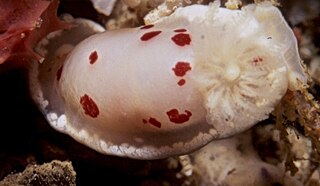
Goniobranchus heatherae, the red-spotted nudibranch, is a species of colourful sea slug, a dorid nudibranch. It is a marine gastropod mollusc in the family Chromodorididae.
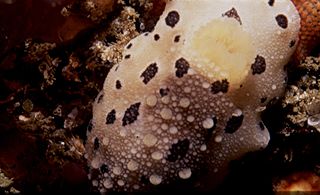
Mandela's nudibranch, Mandelia mirocornata, is a species of sea slug, a dorid nudibranch. It is a marine gastropod mollusc, the only member of the genus Mandelia and the family Mandeliidae. The genus and family name honor Nelson Mandela, the former President of South Africa.

The saddled nudibranch, scientific name Cadlina sp.1 as designated by Gosliner, 1987, is a species of colourful sea slug, a dorid nudibranch. It is a marine gastropod mollusc in the family Cadlinidae.

The blue-speckled nudibranch is a species of sea slug, a dorid nudibranch. It is a marine gastropod mollusc in the family Dendrodorididae.
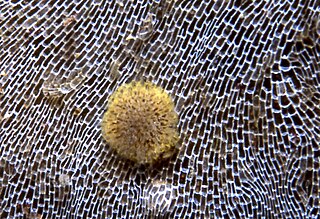
The crazed nudibranch, Corambe sp., as designated by Gosliner, 1987, is a species of sea slug, a dorid nudibranch, a marine gastropod mollusc in the superfamily Onchidoridoidea. It is also known as the moss animal nudibranch because its usual prey is a bryozoan, or moss animal. As at November 2009, it remained undescribed by science.

The crowned nudibranch is a species of dorid nudibranch. It is a marine gastropod mollusc in the family Polyceridae.

Doto pinnatifida, is a species of sea slug, a dendronotid nudibranch, and is found around the United Kingdom and France. It is a marine gastropod mollusc in the family Dotidae.

Janolus longidentatus, the medallion silvertip nudibranch, is a spectacular-looking species of nudibranch, or sea slug. It is a marine gastropod mollusc in the family Proctonotidae.
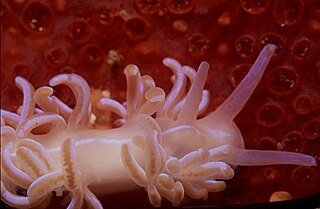
Phyllodesmium horridum, the coral nudibranch, is a species of sea slug, specifically an aeolid nudibranch. It is a marine gastropod mollusc in the family Facelinidae.

Phyllidia coelestis is a species of sea slug, a sacoglossan, a shell-less marine gastropod mollusc in the family Phyllidiidae.
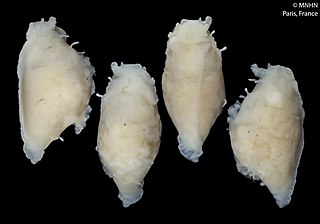
Okenia zoobotryon is a species of sea slug, a dorid nudibranch, a marine gastropod mollusc in the family Goniodorididae. It is normally found on the colonial bryozoan Zoobotryon verticillatum on which it lives and feeds.
Plocamopherus maculatus is a species of sea slug, a nudibranch, a shell-less marine gastropod mollusk in the family Polyceridae.
Polycera tricolor, commonly known as the three-color polycera, is a species of sea slug, a nudibranch, a shell-less marine gastropod mollusc in the family Polyceridae. It occurs in the Pacific Northwest, ranging from southern Alaska southward to northern Mexico, at depths down to about 60 m (200 ft).

















